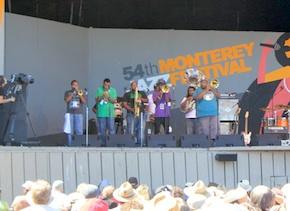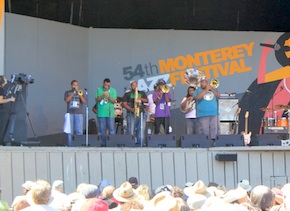
Photos by Jeff Kaliss
Surrounded by eager microphones backstage at Dizzy’s Den, in the middle of this past weekend’s 54th Annual Monterey Jazz Festival, Clint Eastwood, who’d just cohosted a discussion of jazz on film, reminisced about the music that had turned him on as a teen in 1940s Oakland. He cited the seductive sound of saxophonist Lester Young, and the delight of pianist Fats Waller, and said he missed hearing more of Fats’ kind of humor in jazz.
Nobody asked Eastwood what he thought of this year’s bookings at the festival, which he continues to attend and to serve as the best-known member of the board of directors. I put that booking question to San Franciscan filmmaker Kevin White, himself an attendee for over 30 years. “I get the feeling that the board, or [Artistic Director] Tim Jackson, or whoever, decided to open up a little bit and say, ‘We’re gonna try to pull some more people in here,’” said White. “You’ve got the traditionalists that have been coming here for decades. But it felt like [the festival operators] are opening it up beyond just the jazz thing.”
Featured Video
White and I were both happy to get beyond mainstream jazz with “An Afternoon In Treme,” the event that opened up a climatically temperate Saturday’s offerings on the Jimmy Lyons Stage, the principal and largest venue of the seven across the Monterey County Fairgrounds, where the festival has been held since its beginning. This was essentially the same show brought to Davies Symphony Hall three months ago by the folks from the HBO cable television network who’ve already brought you two seasons of Treme, a fictional series about New Orleans musicians and others trying to recover from the long-term impact of Hurricane Katrina, while navigating the twists and turns of their careers and personal issues.
The persistent appeal of [Sly Stone's] songs was apparent in the acclaim from the overflow audience, many of them dancing to the musicServing as emcee on the Lyons Stage was a featured actor from the series, Wendell Pierce, who heralded the arrival of the Soul Rebels, a brass band representing the Crescent City’s second-line tradition by marching through the audience and up onto the stage. It helped attenuate one of the principal drawbacks to main stage action at Monterey, which is the distance between the stage and most of the seats, behind the very-high-price and up-close sections. The high spirits of the Rebels and other New Orleans acts Dumpstaphunk and trumpeter Kermit Ruffins also succeeded in bridging the physical separation and raising the spirits of the largely middle-aged, middle-class audience, who seemed to appreciate the last-minute substitution (for Glen David Andrews) by trumpeter Terence Blanchard, who holds top-drawer jazz credentials and has brought the music to dozens of film soundtracks.
Huey Lewis Gives His News
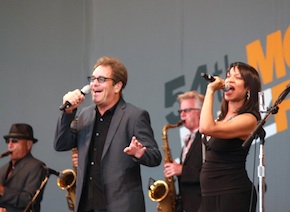
Next up on the Lyons Stage was rock veteran Huey Lewis, whose first-ever appearance at the festival was probably secured by his recent release of Soulsville (on W.O.W. Records), a Memphis-flavored disc not far removed from the repertoire of the blues greats usually booked for Saturday afternoon spots at Monterey. On the strength of personal charisma, and indelible rock recognition, Lewis reduced the psychic space between stage and fans still further, taking care to point out that his recently deceased father had attended the first-ever festival, in 1958, and had become a regular attendee with Lewis’ mother. Distracted temporarily by the roar of low-flying aircraft (the Fairgrounds lie on the flight path of the nearby Monterey Peninsula Airport), Lewis looked up and commented, “That must have been my dad.” He delivered material from the new album artfully, both singing and playing harmonica, backed by several aging members of his brassy band The News, most born and/or musically bred in Northern California, bolstered by younger players and a couple of soulful female backup singers. The group wisely moved its set into several of its ’80s pop hits, proving that “The heart of rock ’n’ roll is still beating,” undiminished by the graying hair of lead saxophonist Johnny Colla, who delivered a searing (and jazz-wise) solo on the song bearing those lyrics. Colla, Lewis, and three other band members later doffed their instruments in a magnetizing a cappella vocal cover of Sixty-Minute Man.
The time gap between the conclusion of the main arena’s last afternoon set (Lewis had extended his beyond the schedule, without letting the appreciative crowd slip from his palm) and the onset of the evening’s offerings provided an opportunity to pick up some eats and drinks, offered in attractive variety but at elevated prices. “Monterey is too expensive, frankly, for many 20-year-olds, and even 30-year-olds,” commented Kevin White over his dinner of ribs, washed down with a margarita. “It’s a pretty expensive weekend, by the time you buy the tickets, find a place to stay, and buy food.” Reflecting on the booking of Lewis and pop vocalist India.Arie, White supposed that “They’re fishing for an older demographic that may or may not like jazz.”
“These are young guys that are taking the music seriously, and trying to take it to new places.” – Kevin White
While seated at one of the picnic-style tables near the entrance to the Fairgrounds, chowing down on my own serving of barbecued chicken in a teriyaki bowl (fetched by my faithful spouse and helpmate, Louise Whitlock), I was also able to enjoy the proximate sounds of Dumpstaphunk, the band led by Neville Brothers scion Ivan Neville, which had been transplanted from the main arena to the smaller (and less expensive) Garden Stage. They’d been joined by dynamic Petaluma-based drummer Greg Errico, whose rock pedigree they acknowledged with several selections from the songbook of Sly Stone, Errico’s superstar employer from four-plus decades ago. The persistent appeal of these songs, long outliving the duration of the band (The Family Stone) which originally recorded them, was apparent in the acclaim from the overflow audience, many of them dancing to the music.
Cool Approach
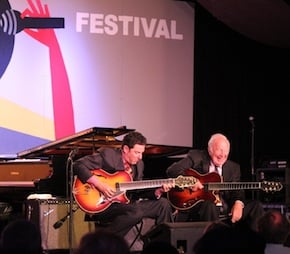
Jazz per se was more in evidence on Saturday evening, though mostly not in those forms that prevailed in the era of Eastwood’s youth. At the Lyons Stage, Geri Allen and her group Timeline manifested a virtuosic, rather cool approach to pianist Allen’s original compositions, made livelier, in the debut of a piece commissioned by the festival, by tap dancer Maurice Chestnut, who functioned as an aurally and visually fascinating additional percussion instrument. They were followed by the group James Farm — saxophonist Joshua Redman, pianist Aaron Parks, bassist Matt Penman, and drummer Eric Harland (check the given names for a possible clue to the derivation of the group name) — about which Kevin White later expressed his enthusiasm. “What I liked was the whole idea about having a combo where they’re all composers and play each other’s music,” he said. “These are young guys that are taking the music seriously, and trying to take it to new places.” To me, that place seemed at times cerebral, but at other times melody and soul shone through.
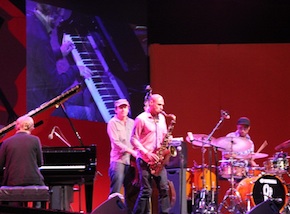
A quick stroll through the cool evening across the Fairgrounds to the Dizzy’s Den building, where I’d earlier encountered Clint Eastwood, brought Louise and me closer to the sort of music Clint said he favored, as showcased by a guitarist four years Clint’s senior — Bucky Pizzarelli — and his 51-year-old guitarist/vocalist/radio host son, John. Their flip through the American Songbook was breezy and good-natured, enhanced by the additional bass string on Bucky’s instrument and John’s humorous musical quotes, including a riff from Deep Purple’s Smoke on the Water, which got the audience giggling. Back at the main stage, Herbie Hancock led an adoring late-night crowd into fresh territory, as he always has done, playing a strap-on Roland AX-Synth and jamming joyously through both new material and such golden oldies as his Watermelon Man.
The single day I had at Monterey was certainly not enough to see every act I’d have considered worthwhile, or to hook up with all the artists I already knew or wanted to meet. For Kevin White and his wife, Annamarie Faro, it’s their fellow attendees who are an important part of the draw. “Everybody we sit with [in the main arena], we can’t wait to see ’em, and that’s still part of the festival, and that’s not gonna go away,” testified White. “I’m seeing kids that used to be 3-year-olds with their parents, and now, as adults, they’re coming back.” Also returning, and roaming the grounds, were such familiar elders of the jazz world as record producer Orrin Keepnews and educator and broadcaster Herb Wong, while a whole new crop was served up in the Next Generation Jazz Orchestra on Sunday afternoon, under the guidance of current jazz stars Benny Green and artist in residence Joshua Redman, who had themselves both visited the festival as talented Berkeley High players, in the 1980s.
The closing act of this year’s festival was one of the most compelling embodiments of the vitality of jazz, both in his playing and in his personal approach to the music, which he shared with me in a phone interview three months ago. “This is a very dear subject to me, Jeff, because I believe jazz is so much a real part of freedom, which America is supposed to be about,” said 81-year-old saxophonist Sonny Rollins. “I’m still experimenting, I’m still searching for that lost chord. We still make music by playing out in front of people, by people seeing real music being made spontaneously. And I can learn so much more when I’m performing than I can practicing at home. When I do a concert, I can play one thing, and it enlightens me right away.”

